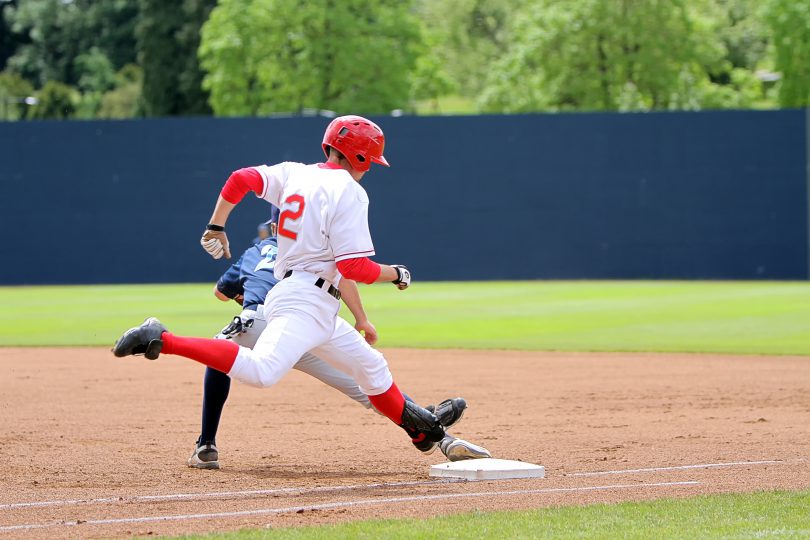We recently posted our yearly series to help get your base running skills ready for the college level. In the first article, we shared some “universals” that apply to running the bases. These rules apply no matter where you are on the base paths. Now, it’s time to start talking about specific ways to improve your base running, right out of the box, based on your starting point. We’ll start as the batter runner. You’ve just put the ball in play. What do you do next? Let’s take a look:
Once the ball is put in play, your first job is to start running. Don’t make assumptions, just run as hard as you can. As you take your first few steps in a straight line to 1st, peek at the ball and analyze the situation. In doing this, you should be able to determine what type of route you need to take to 1st base.
Depending on where you hit the ball, you may have to peek farther down the line and adjust from there. When you decide what base you will be trying to get to, you want to get to that base as quickly as possible. This may seem obvious. But, we often see younger players have to slow up around a base because their route wasn’t set up for their destination base. Adjustments must be made based on bobbles and errors, of course!. But let’s not get ahead of ourselves. Below we tackle what to do on several different kinds of hits. After peeking and reading the ball, here’s what to do when…
There might be a contested play at first: Run hard through 1st
Route: Maintain a straight line to 1st out of the box and run hard all the way through the base. Make it a point to have distance between you and the base before slowing down. This will create separation between you and the bag. It will help umpires know you are safe on close calls, as we describe in detail here.
Details:
- Step on the front of first base with whichever foot gets you to the base without breaking stride. Hitting the front of the base can’t be over-emphasized enough. It is the quickest and safest route.
- DO NOT lunge/jump to reach the base (this will slow you down).
- After running through the base completely, drop your hips, chop your steps. Look over your right shoulder for an overthrow that would allow you to get to 2nd base.
- Dive head first only to avoid a tag by the person covering 1B. Diving has proven to be slower than properly running through the base. Take a look at this video here. Talk to your coach about his rules about diving head first – he may not want you diving to first under any circumstances.
A sure single to the outfield with no potential play at first or a potential double: Rounding 1st and preparing for second
Route: Any sure single can turn into a potential double with the right mindset. And most of the time your chances at second are determined by your first few steps out of the box. When you hit a sure single to the outfield, think double right away and run as hard as you can. Always anticipate an outfield bobble or a ball that will allow you to get to second. You can always put on the breaks. Start getting wide as soon as you know the ball will get to the outfield. Then, there will be no play at 1st. Getting wide early will allow you to hit 1B running full speed. You’ll get to second in the quickest time possible.
Use a banana curve rather than the question mark route. The “?” route to first forces you to try to make quick direction changes at full speed. It is not possible to make big direction changes like this without slowing down.It will cost you valuable time. Get the only the depth you need in your curve to maintain full speed. The wider your get, the longer the distance you have to cover.
Details:
- Hit the inside corner of 1B and drop your left shoulder, allowing yourself to drive towards 2nd in a more direct path to second while maintaining full speed.
- Find the appropriate curve around 1st to allow you to round the base without losing speed. This will be a balance between direction and speed. You want to keep your direction to second (not get too wide) but also don’t want to sacrifice speed. This path can be different for everyone, but it is something you will want to work on at practice and with a stopwatch. Data doesn’t lie.
- Keep your head up and your eye on the ball. Round the base aggressively, anticipating a bobble that may allow you to move up. Think “Go, go, go!” until the fielder or the location of the ball makes you stop. Only take your eyes off the play to look at 1st base as you approach it, so you do not trip or miss the base.
- On a possible double that could be contested by a throw, you should follow the same route out of the box. You want to be able to get to 2nd as fast as possible, which may mean that you may have to be a bit slower to 1st in order to cut down your overall time from home to 2nd.
- There should be no difference between a sure single and a possible double in terms of mindset, effort, or route. In both situations, you are preparing to make it to second and shutting it down when the play tells you that you can’t.
Sure stand–up double or potential triple.
Route: On a sure stand-up double that you would like to turn into a triple, your path out of the box and around the bases should represent getting to third as quickly as possible. Just as you sacrifice time from home to 1st in order to get to second faster in a potential double situation, you do the same for getting to 3rd. You want to set a route that will allow you to go full speed from home to 3rd, while traveling the least distance to do so. This often means you will be running close to a straight line from second to third.
Details:
- You will find a lot of similarities between this and the last route. You should always be anticipating taking the extra base (3rd).
- You will be slower getting to 2nd than you would on a contested double, but your concern is getting to 3rd base as quickly as possible.
- Hit the inside corner of 1st base and 2nd base, dropping your left shoulder to allow yourself to keep momentum going towards the next base.
- Instead of trying to keep the distance short from 1st to 2nd, stay wide enough so you will not have to slow down on your way to third. Doing this well means you will have a relatively straight path from 2nd to 3rd.
You probably have already figured out the route you would take on a sure triple, so we will leave you to your practice. When in doubt, follow the simple rule that you want to take a route that will allow you to run the shortest distance you can right out of the box without having to slow down at any point along the way. This takes practice. Technique and details are incredibly important. Most important of all is the mindset that you will put pressure on the defense and prepare to take the extra base on every single play. That’s college level base running.
In the next article of our base running mini-series, we share base running tips for when you are already on base. Check back for that article later in the week.







